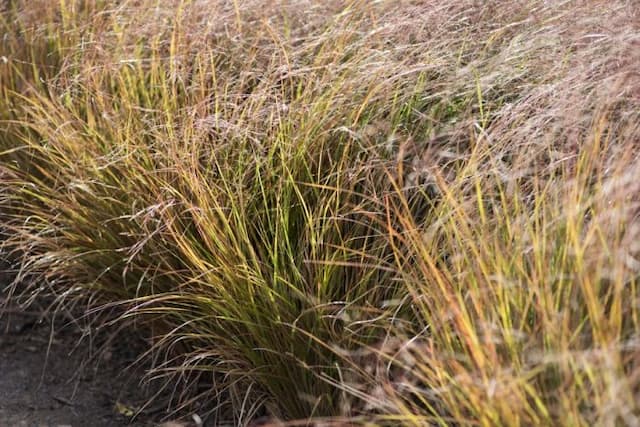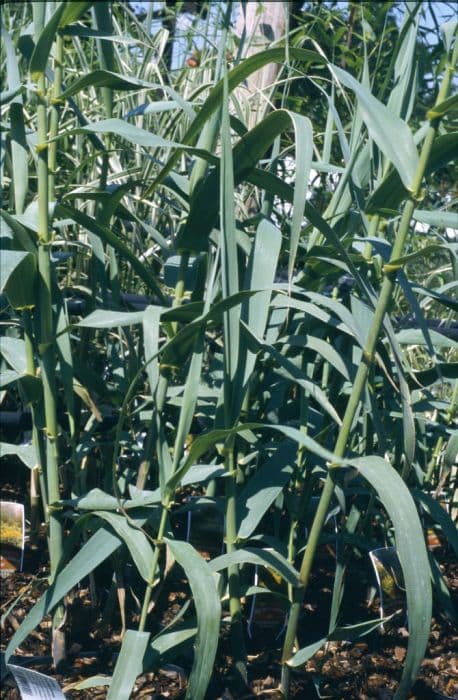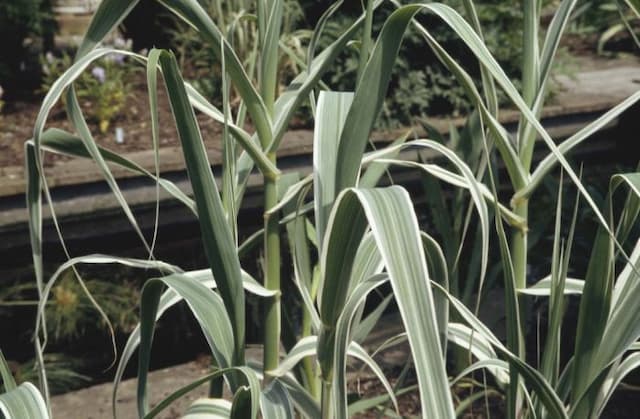Pampas Grass Cortaderia selloana 'Highfield Pink'

ABOUT
The plant commonly known as 'Highfield Pink' pampas grass features a distinctive appearance with showy, feathery plumes. These plumes are a soft pink color, providing a gentle but striking visual interest in the garden landscape. The foliage of this plant consists of long, narrow leaves that arch gracefully, creating a dense, flowing clump. The leaves may have a sharp edge, so careful handling is recommended. The pink plumes rise above the foliage, catching the eye with their color and movement in the breeze. Their texture is fluffy and silky, giving them an almost ethereal quality as they shimmer in the light. The overall visage of 'Highfield Pink' pampas grass is one of elegant beauty, with its blend of pastel tones and fine leaf structure, it offers a soft visual appeal that contrasts well against the greenery of other plants or the structures of the built environment.
About this plant
 Names
NamesFamily
Poaceae
Synonyms
Pink Pampas Grass, Pink Feather Grass
Common names
Cortaderia selloana 'Highfield Pink'.
 Characteristics
CharacteristicsLife cycle
Perennials
Foliage type
Evergreen
Color of leaves
Green
Flower color
Pink
Height
6 feet (1.8 meters)
Spread
4 feet (1.2 meters)
Plant type
Grass
Hardiness zones
7
Native area
South America
Benefits
 General Benefits
General Benefits- Ornamental value: Adds a soft, fluffy texture and a subtle pink hue to gardens with its showy plumes.
- Drought tolerance: Once established, it has low water requirements, making it suitable for xeriscaping.
- Low maintenance: Requires minimal care once established, apart from occasional removal of dead foliage and plumes.
- Long blooming period: Produces flowers from late summer through fall, providing extended visual interest in the landscape.
- Wildlife habitat: Can provide shelter for birds and insects within its dense foliage.
- Erosion control: Its robust root system can help stabilize slopes and banks, preventing soil erosion.
- Windbreak: Can act as a natural wind barrier when planted in groups, protecting gardens and structures from wind damage.
- Privacy screen: With its height and dense growth, it's effective for creating a natural and visually appealing screen for privacy.
- Adaptable: Tolerates a range of soil types, from sandy to heavy clay, provided they are well-draining.
- Cold hardy: Can survive in colder climates where many other ornamental grasses may not thrive.
 Medical Properties
Medical PropertiesThis plant is not used for medical purposes.
 Air-purifying Qualities
Air-purifying QualitiesThis plant is not specifically known for air purifying qualities.
 Other Uses
Other Uses- Privacy Screen: The dense growth of Pampas Grass 'Highfield Pink' can be used to create a natural and attractive privacy barrier between properties.
- Sound Barrier: The thick foliage helps dampen noise pollution, making it suitable for planting along roads or noisy areas.
- Erosion Control: Its sturdy root system can help stabilize soil on slopes and prevent erosion.
- Windbreak: Taller varieties of Pampas Grass can serve as windbreaks, providing protection for smaller, less hardy plants.
- Themed Gardens: 'Highfield Pink' adds a striking texture and color to themed gardens, such as a pink garden or a tropical-themed landscape.
- Biofuel Source: The biomass of Pampas Grass has potential as a source of biofuel, although this use is in the early stages of research and development.
- Architectural Accent: Its distinctive fluffy plumes make Pampas Grass an artistic addition to modern architectural designs and garden landscapes.
- Wedding Decorations: Dried plumes of 'Highfield Pink' are often used in floral arrangements and as decorations for weddings and other events.
- Craft Material: The dried plumes and leaves can be used in crafts, like making wreaths or as part of ornamental displays.
- Photography Prop: It's increasingly popular as a background plant in photography, providing a soft, natural setting for portraits and artistic shots.
Interesting Facts
 Feng Shui
Feng ShuiThe Pampas Grass is not used in Feng Shui practice.
 Zodiac Sign Compitability
Zodiac Sign CompitabilityThe Pampas Grass is not used in astrology practice.
 Plant Symbolism
Plant Symbolism- Beauty in Growth: The Cortaderia selloana, commonly known as Pampas Grass, boasts showy plumes which can symbolize beauty and the aesthetic pleasure of witnessing growth and development.
- Resilience and Adaptability: Pampas Grass is known for its ability to thrive in various conditions, making it a symbol of resilience and adaptability in the face of changing environments.
- Privacy and Protection: The tall and dense nature of Pampas Grass can provide a natural barrier, symbolizing the need for privacy and the concept of safeguarding one's space.
- Freedom and Ease: The way Pampas Grass moves with the wind can evoke a sense of freedom and ease, reflecting an ability to go with the flow of life's circumstances.
- Invincibility: In some cultures, the robust nature of Pampas Grass leads it to be associated with strength and invincibility, standing tall against adversity.
 Water
WaterThe Pampas Grass 'Highfield Pink' prefers to be watered deeply but infrequently, to mirror natural rainfall. This grass should be watered generously, ensuring that the water penetrates the soil to reach the deep roots, approximately once a week during dry periods. In average conditions, aim for about 1 inch of water per week, whether from rainfall or manual watering. During particularly hot or dry spells, you may need to water twice a week, adjusting to about 1.5 to 2 gallons per plant per watering session to maintain soil moisture.
 Light
LightPampas Grass 'Highfield Pink' thrives best in full sunlight for at least 6 hours a day, making it ideal for open landscapes where it can receive unfiltered, direct light. An optimal spot for this grass would be an area with southern or western exposure, ensuring that it gets ample sunlight throughout the day to maintain its vibrant color and encourage full plumes.
 Temperature
TemperaturePampas Grass 'Highfield Pink' is hardy and can tolerate a wide range of temperatures, but it performs best in environments where the temperature stays between 40°F and 90°F. This grass can survive minimum temperatures down to about 20°F, but for optimal growth and plume production, maintaining conditions within the ideal range is recommended. It is generally advisable to plant it in a location that avoids the extreme cold to prevent frost damage to the foliage.
 Pruning
PruningPampas Grass 'Highfield Pink' should be pruned to remove old foliage and encourage new growth. The best time to prune is late winter or early spring, before new growth starts. Cut back the grass to about 1 to 2 feet from the ground, wearing gloves to protect against the sharp edges of the leaves. Pruning annually will ensure the health of the plant and the development of full, attractive plumes.
 Cleaning
CleaningAs needed
 Soil
SoilPampas Grass prefers well-draining soil with a pH range of 6.1 to 7.8. A soil mix consisting of loam, sand, and peat works best to ensure proper drainage and aeration. It's important to avoid waterlogged conditions which can lead to root rot.
 Repotting
RepottingPampas Grass is a large, fast-growing plant and typically does not require frequent repotting once established outdoors. If grown in containers, it may need repotting every 2-3 years to provide fresh soil and additional space for root growth.
 Humidity & Misting
Humidity & MistingPampas Grass is tolerant of a wide range of humidity levels and thrives in average ambient humidity. Excessive humidity is not required; the plant is well-adapted to outdoor conditions where it naturally experiences fluctuations in humidity levels.
 Suitable locations
Suitable locationsIndoor
Ensure full sun, infrequent watering, and well-draining pot mix.
Outdoor
Plant in full sun, well-draining soil, space widely, low maintenance.
Hardiness zone
7-11 USDA
 Life cycle
Life cycleThe Pampas Grass 'Highfield Pink' (Cortaderia selloana 'Highfield Pink') begins its life as seeds that germinate in spring to early summer, requiring warm temperatures and well-drained soil. Seedlings emerge and establish a strong root system, developing into clumps of narrow, arching green leaves. Over the first few years, the grass matures and increases in size, developing its characteristic tussock-forming habit. In late summer to autumn, the mature Pampas Grass produces its distinctive pink feathery plumes that can reach several feet in height, attracting pollinators and providing visual interest. After flowering, the plumes turn to seed, which can be dispersed by wind to propagate new plants. As temperatures cool and winter approaches, the grass may enter a period of dormancy, particularly in colder climates, until warmth and light increase in the spring, triggering a new cycle of growth.
 Propogation
PropogationPropogation time
Spring-Early Summer
Pampas grass, specifically the Cortaderia selloana 'Highfield Pink', is best propagated by division, which is the process of separating an established clump into several smaller sections. This method is popular because it maintains the characteristics of the parent plant and is relatively simple. Propagation by division is ideally done in late winter or early spring before new growth begins. The gardener should dig up the entire plant, ensuring a large root ball is intact, and then use a sharp spade or knife to slice through the dense roots to create new plants, each with a portion of the original root system and several shoots. These divisions can then be replanted immediately, spaced about 6 feet (approximately 1.8 meters) apart to allow sufficient room for growth. It's important to water the new divisions well to help establish them.









